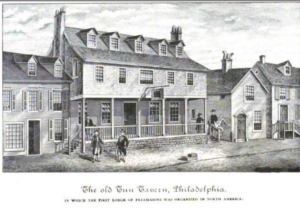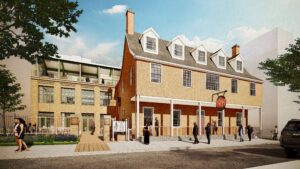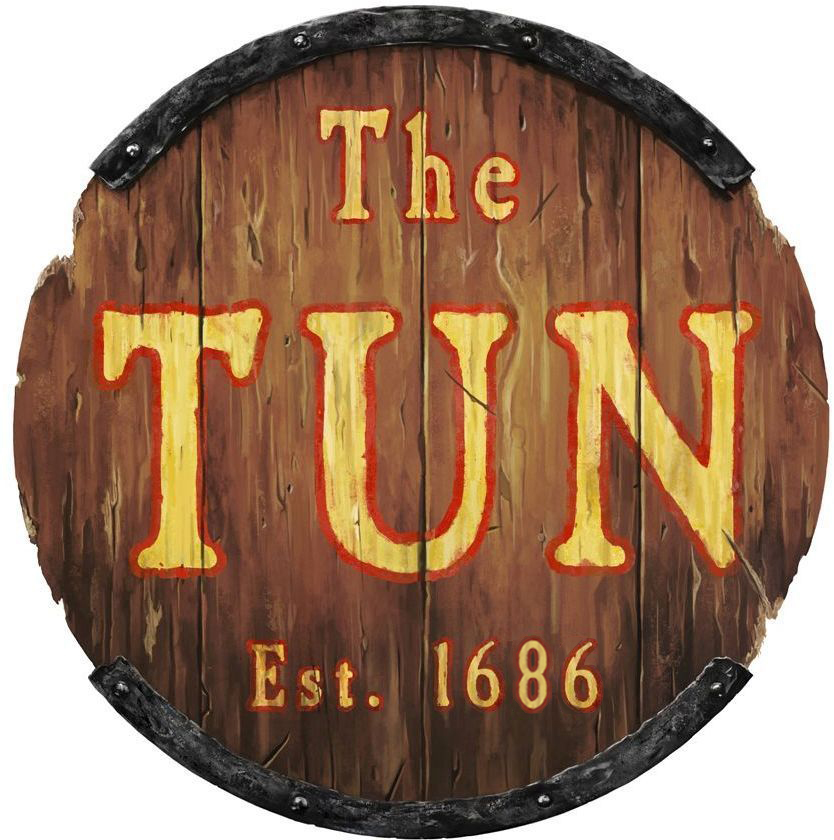
Source: 1889 unattributed woodcut (Gould 1889)

Source: Tun Legacy Foundation
The Tun was an iconic building in colonial-era Philadelphia for nearly a century. It served as a hub of community life and an important meeting place for historic groups. Despite its significance, the original Tun building, which was likely built in the 1690s, was demolished in 1781, more than 240 years ago, leaving some of its history a mystery.
A research project commissioned by the Tun Legacy Foundation, and conducted by Richard Grubb & Associates, Inc. (RGA) of Cranbury, N.J., sought to discover information about the appearance of the Tun to inform the work of Ballinger, the Philadelphia architectural firm designing and building The Tun®.
The research and report represent a collaborative effort by RGA’s Robert J. Wise Jr., principal senior architectural historian; Seth Hinshaw senior historian; Teresa Bulger, senior historian; and Kristen Herrick, senior architectural historian. The team completed their research at the Philadelphia Free Library, the Historical Society of Pennsylvania, the Philadelphia City Archives, and the Library Company of Philadelphia, and also utilized published primary and secondary sources and websites.
Drawing on archival records and architectural analysis, the historians accomplished three things:
- First, they traced the Tun’s in-depth history.
- Next, they reviewed seven depictions of the Tun, analyzing the context and accuracy of each.
- Finally, they discussed known physical characteristics and provided recommendations to the Tun Legacy Foundation for architectural elements that may be incorporated into the design of The Tun®.
Future issues of this newsletter will share details about the Tun’s history as documented in the report, shedding new light on the storied establishment and its place in Philadelphia’s and America’s history.
From land acquisition to construction, we will learn about the tavern’s origins. We will meet the multiple business and community leaders who operated the Tun. And we will gain an awareness of how Tun looked over the years.
For example, did you know?
- Taverns served a vital role in the creation of the new American Republic. Researcher Baylen J. Linneken noted that taverns were “vital centers where colonists of reputations great and small gathered to read printed tracts, speak with each other on important issues of the day, debate the news, organize boycotts, draft treatises and demands, plot expulsion of their British overlords, and establish a new nation.” (Source: 2012, Baylen J. Linneken, Tavern Talk and the Origins of the Assembly Clause: Tracing the First Amendment’s Clause Back to Its Roots in Colonial Taverns. Hastings Constitutional Law Quarterly 39 (3):593-628.) Some argue that the right to assemble, codified in the First Amendment to the Constitution, was born out of colonial American taverns.
- Colonial taverns of the seventeenth and eighteenth centuries were typically operated out of dwelling houses, which served multiple purposes. For this reason, tavern architecture did not conform to one particular style, but rather drew on vernacular architectural forms, and taverns were visually similar to other domestic and commercial buildings. (Source: 2003, A.K. Sandoval-Strausz, A Public House for a New Republic: The Architecture of Accommodation and the American State, 1789-1809. Perspectives in Vernacular Architecture 9:54-70).
- Built as one of the earliest taverns in Philadelphia, the Tun was likely expanded in the early eighteenth century. Thereafter, several social groups began to meet there, including the first Masonic group in Pennsylvania and three groups that assisted people moving to the colony from Europe – the St. George’s, St. Patrick’s, and St. Andrew’s societies.
These are just a few of the details shared in the report.
“The new historical study offers fresh insights that will inform efforts to preserve and interpret the Tun’s legacy,” said Pat Dailey, president and founder of the Tun Legacy Foundation. “By analyzing the tavern’s architectural features and comparing them to other colonial-era structures, the report provides recommendations for how a historically accurate reconstruction might look.”
As the Tun Legacy Foundation shares details from this comprehensive study, it hopes to spark interest in rediscovering and celebrating this historic institution’s history. Through careful interpretation, the spirit of the Tun can once again come to life.
For more insights and updates on The Tun®, its design, features, and history, please follow this newsletter and invite others to subscribe. As the Tun Legacy Foundation prepares for the November 2024 groundbreaking for The Tun®, please consider making a donation. https://thetun.org/contribute/general-contributions/
